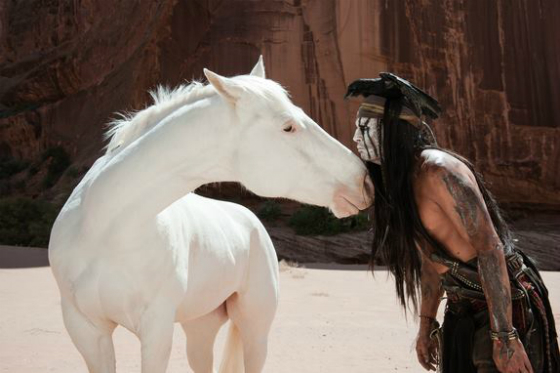ill LYTeracy – Reconsidering The Lone Ranger‘s Ending
 |
Blame Quentin Tarantino. In his urge to seize headlines, he created an early top ten movies list of 2013, and got me thinking about The Lone Ranger again, which he has dubbed one of the best of the year.
Not that Tarantino’s stamp necessarily means you have proper back-up, of course. This is, after all, a guy who thinks Kick-Ass 2 is also one of the year’s best, that Batman is a boring character, and that it’s anything but absurd to do a best-of list in October when many of the likely best have yet to be released (if critics did likewise, several Tarantino movies would have been left out in the cold). But hey, welcome to the party, Quentin. I’ll take fellow Lone Ranger fans where I can get them.
If you aren’t already familiar with my idiosyncratic read of The Lone Ranger, I’ll give it to you in a nutshell: it’s an unreliable tale told by a slightly crazy and broken old man, namely Tonto, who’s attempting to retcon his life and recast himself as the hero. Some think I’m full of it; others express some interest in how I saw it. But people on both sides have asked me what the final shot means – that image over the end credits of old Tonto walking off into the desert. Until recently, I did not have a good answer. The danger in reviewing movies as quickly as we do is that not everything sinks in right away. My initial take was that maybe it symbolized a small man in a big world, or his loneliness at being the last of his tribe. I think there’s a lot more to it now.
Okay, so whether I’m “right” in my interpretation or not – you could argue that my personal interpretation can never be “wrong” to me , but I’m thinking in terms of director intent – we begin with something that’s fairly indisputable. There is a recurring motif of pocket watches in the film. They are called attention to. The simplest read of the watch as metaphor is that it symbolizes time, but it is also notable that in every instance where a pocket watch becomes significant to the story, it is as a gift followed immediately by betrayal – to Tonto as a boy, to the mayor by the main villain, as a bait and switch by the heroes later. Time has betrayed old man Tonto. Tonto’s pocket watch has been cracked, and is stopped – he is still stuck in that moment of betrayal, and cannot move forward.
Paralleling this, he is stuck in a moment in the past when we first meet him as an old man – literally, as he is first seen as a frozen waxwork-like figure in a travelling museum exhibit. What brings him out of it? The chance to tell a story. He initially mistakes the boy for the Lone Ranger because he cannot process that time has moved on for everyone else; as he tells the story, dark events like the mass-killing of his people edge their way in even as he tries to maintain a whimsical tone.
And in telling the story, he frees himself. Having re-assessed himself as the hero rather than a victim, he can move on – no longer trapped by the memory or the exhibit that represents it. He is free at the end, and his leaving the told story behind him even mirrors the behavior of the audience member leaving the theater, having been held in that moment themselves for a couple of hours.
When Tonto tells the Lone Ranger, “Never do that again!” after the “Hi-ho, Silver!” moment, most read it as a tacky joke; a cheap shot at the character’s legacy. But if I recall correctly, those are also the last words spoken by Tonto in the flashback story. Think about them in the context of no longer being trapped by a memory – The Lone Ranger never will do that again, because the story is told, and Tonto is done reliving it.
I’m actually just a little bit glad there won’t be a sequel now – this is a story complete in itself, and if I’m even remotely right in my understanding, continuing the adventures would fundamentally have to change all of that. I hope those who missed it might give it a chance when it finally hits Blu-ray in December.
Now go ahead, Internet: tell me why I’m full of it.
